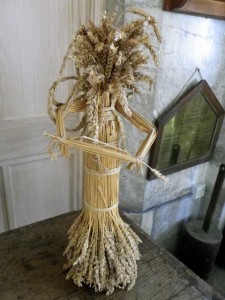The following article is about the history of the Corn Dolly.
Do we known of an expert on Lincolnshire Corn Dollies? It would be good to include designs on this website.
Corn Dollies are as old as agriculture. The name comes from “Idol” or “Image”, and we know that in  some cultures the figure of a woman was made from straw at harvest time. Other peoples made symbols of fertility and plenty in the shape of mares, goats and cornucopias. Possibly the traditional cigar-shaped dolly was based on the ‘horn of plenty’. Straw is an impermanent material and nothing physical has come down to us from ancient times, but we know that wheat was cultivated in Egypt at least 6000 years B.C., and carvings exist on old tombs looking very much like plaited straw work. The oldest known designs are the Aruseh, or Corn Bride, a design found in Egypt and the Mediterranean area. It was made from the best ears of wheat and was hung in the larder as a charm to ensure against hardship. The basic idea behind the corn dolly is that the Spirit of the Corn resided in the last sheaf gathered at harvest time, and special ceremonies attended its cutting. Often a figure or a traditional design would be made from this sheaf that would be preserved in the farmhouse until the following year in the belief that the Spirit would ensure that the seed corn would germinate in the following spring. In early times this Spirit or Goddess was known as Demeter to the Greeks and Ceres to the Romans. The techniques of corn dolly making have been handed down through generations of farmers and their workers, and although the original beliefs behind them have been long forgotten many designs have survived for us to recreate today, together with newer and more up-to-date ideas. British dollies vary from county to county. For example, the bell and the umbrella come from Cambridgeshire, the horseshoe is from Suffolk and Essex has the terret, a shape copied from a horse brass. Mordiford, a village near Hereford, gives us the heart-shaped design that bears its name. Ireland produced crosses and favours, the latter being a simple 2-straw plait that a young country lad might have made for his girt friend on an evening walk. The ribbons that usually accompany corn dollies are a traditional embellishment. Modern varieties of wheat are bred for the combine harvester, and being short and stiff are useless for straw work. Most dollies are made from older types of wheat which have been specially grown for the purpose and often cut by hand.
some cultures the figure of a woman was made from straw at harvest time. Other peoples made symbols of fertility and plenty in the shape of mares, goats and cornucopias. Possibly the traditional cigar-shaped dolly was based on the ‘horn of plenty’. Straw is an impermanent material and nothing physical has come down to us from ancient times, but we know that wheat was cultivated in Egypt at least 6000 years B.C., and carvings exist on old tombs looking very much like plaited straw work. The oldest known designs are the Aruseh, or Corn Bride, a design found in Egypt and the Mediterranean area. It was made from the best ears of wheat and was hung in the larder as a charm to ensure against hardship. The basic idea behind the corn dolly is that the Spirit of the Corn resided in the last sheaf gathered at harvest time, and special ceremonies attended its cutting. Often a figure or a traditional design would be made from this sheaf that would be preserved in the farmhouse until the following year in the belief that the Spirit would ensure that the seed corn would germinate in the following spring. In early times this Spirit or Goddess was known as Demeter to the Greeks and Ceres to the Romans. The techniques of corn dolly making have been handed down through generations of farmers and their workers, and although the original beliefs behind them have been long forgotten many designs have survived for us to recreate today, together with newer and more up-to-date ideas. British dollies vary from county to county. For example, the bell and the umbrella come from Cambridgeshire, the horseshoe is from Suffolk and Essex has the terret, a shape copied from a horse brass. Mordiford, a village near Hereford, gives us the heart-shaped design that bears its name. Ireland produced crosses and favours, the latter being a simple 2-straw plait that a young country lad might have made for his girt friend on an evening walk. The ribbons that usually accompany corn dollies are a traditional embellishment. Modern varieties of wheat are bred for the combine harvester, and being short and stiff are useless for straw work. Most dollies are made from older types of wheat which have been specially grown for the purpose and often cut by hand.
